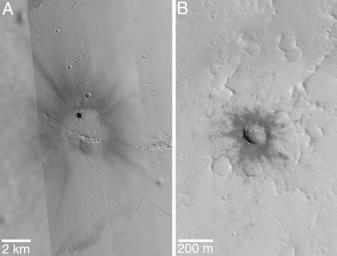
|
Fresh Impact Crater and Rays in Tharsis
- Click the image above for a larger view
- Full-Res JPEG (3889 x 2958) (828.3 kB)
- Full-Res TIFF (3889 x 2958) (7.3 MB)
Caption:
The Mars Global Surveyor (MGS) Mars Orbiter Camera (MOC) Extended Mission has included dozens of opportunities to point the spacecraft directly at features of interest so that pictures of things not seen during the earlier Mapping Mission can be obtained. The example shown here is a small meteorite impact crater in northern Tharsis near 17.2°N, 113.8°W. Viking Orbiter images from the late 1970's showed at this location what appeared to be a dark patch with dark rays emanating from a brighter center. The MOC team surmised that the dark rays may be indicating the location of afresh crater formed by impact sometime in the past few centuries (since dark ray are quickly covered by dust falling out of the martian atmosphere). All through MOC's Mapping Mission in 1999 and 2000, attempts were made to image the crater as predictions indicated that the spacecraft would pass over the site, but the crater was never seen. Finally, in June 2001, Extended Mission operations allowed the MOC team to point the spacecraft (and hence the camera, which is fixed to the spacecraft) directly at the center of the dark rays, where we expected to find the crater.
The picture on the left (above, A) is a mosaic of three MOC high resolution images and one much lower-resolution Viking image. From left to right, the images used in the mosaic are: Viking 1 516A55, MOC E05-01904, MOCM21-00272, and MOC M08-03697. Image E05-01904 is the one taken in June 2001 by pointing the spacecraft. It captured the impact crater responsible for the rays. A close-up of the crater, which is only 130 meters (427 ft) across, is shown on the right (above, B). This crater is only one-tenth the size of the famous Meteor Crater in northern Arizona.
The June 2001 MOC image reveals many surprises about this feature. For one, the crater is not located at the center of the bright area from which the dark rays radiate. The rays point to the center of this bright area, not the crater. Further, the dark material ejected from the crater--immediately adjacent to the crater rim in the picture on the right (above, B)--is not continuously connected to the larger pattern of rays. Asymmetries in crater form and ejecta patterns are generally believed to occur when the impact is oblique to the surface. The offset of the crater from the center of the rays suggests that the meteor struck at an angle, most likely from the bottom/lower right (south/southeast). The strange geometry of the rays is quite different from that seen for rays associated with impact craters on the Moon and other airless bodies; one possible explanation is that they resulted from disruption of dust on the martian surface by winds generated by the shock wave as the meteor plunged through the martian atmosphere before it struck the ground.
Background Info:
Malin Space Science Systems and the California Institute of Technology built the MOC using spare hardware from the Mars Observer mission. MSSS operates the camera from its facilities in San Diego, CA. The Jet Propulsion Laboratory's Mars Surveyor Operations Project operates the Mars Global Surveyor spacecraft with its industrial partner, Lockheed Martin Astronautics, from facilities in Pasadena, CA and Denver, CO.
Cataloging Keywords:
| Name | Value | Additional Values |
|---|---|---|
| Target | Mars | |
| System | ||
| Target Type | Planet | |
| Mission | Mars Global Surveyor (MGS) | Viking |
| Instrument Host | Mars Global Surveyor | |
| Host Type | Orbiter | |
| Instrument | Mars Orbiter Camera (MOC) | |
| Detector | ||
| Extra Keywords | Atmosphere, Crater, Dust, Grayscale, Impact, Moon | |
| Acquisition Date | ||
| Release Date | 2002-02-16 | |
| Date in Caption | ||
| Image Credit | NASA/JPL/MSSS | |
| Source | photojournal.jpl.nasa.gov/catalog/PIA03469 | |
| Identifier | PIA03469 | |
